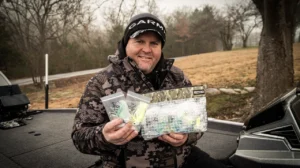If you’ve been fishing long enough, you’ve probably thought, “they just don’t bite like they used to.” I know I’ve muttered those words more times than I’d like to admit. Over the years, I’ve watched many different waterbodies change, in both fresh and salt water. The behavior of the fish more than anything else changes. Whether it’s bass, trout, walleye, or crappie fishing, it often feels like these fish have gotten smarter, warier, or harder to fool. The truth is, I think they have.
It makes you think, what has actually happened? Let’s break down why fish are becoming harder to catch and what that means for us anglers. This could be for the better or worse for our sport.
Fishing Pressure: The Cold Hard Truth
Fish may not have big brains like us, but they absolutely learn from experience. A bass that’s been caught once or twice starts to recognize that some lures just aren’t food. A trout that’s been hooked on a certain fly may not rise to it again so quickly. Even panfish, which most people think of as simple, learn to shy away from hooks in heavily pressured waters.
Modern fishing has exploded in popularity, likely supercharged by the internet. There are more boats on the water, more kayaks, and more anglers than ever before. Add in advanced gear, liveview sonar, and social media where hot bites get shared instantly — fish don’t get much of a break. The same spots get hammered week after week, and those fish wise up fast.
I’ve seen lakes where a new lure works like magic for one season, then by the next year it’s just another bait that fish ignore. That’s not coincidence; it’s fishing pressure. Ever since the years of COVID, when people lost their jobs and everyone went fishing, our waters have changed. People bought boats, many still have them. There are more anglers out on the water and the amount of fish being targeted has not changed. Even on weekdays, the boat ramps are packed. The fish don’t get a break.
Advances in Tackle: A Double-Edged Sword

As technology advances into the future, we’ve created better tools in fishing than ever before. Side imaging, forward-facing sonar, ultra-sensitive rods, and lifelike lures give us more power than anglers had a generation ago. But here’s the flip side, some of those tools put more stress on fish. We’re able to find schools that used to stay hidden, or catch deepwater fish that used to be considered uncatchable.
Don’t get me wrong, technology has its time and place — I’m a big proponent of using it myself. But when every angler on the lake can scan an offshore hump and put a bait right in front of a fish’s nose, it doesn’t take long before those fish figure out something’s amiss. The more they get hooked and released, the more cautious they become.
As much as I’m a big supporter of forward facing sonar, almost to a point where I can’t fish without it, it has been known to turn fish off from biting. When I first installed FFS on my boat, after turning it on, I jumped in the water to see how loud the transducer was. Every kind of transducer emits some noise. As soon as I hit the water and stuck my head underneath, my ears started pinging louder than shooting a gun without hearing protection. It was ear piercing. Now, imagine being in an area with multiple boats chasing fish. That’s the reason why some fish just swim away when forward facing sonar is aimed toward them.
Environmental Changes and Water Clarity
Another big factor is the water itself. Many lakes are clearer today than they were years ago, thanks to invasive species like zebra mussels. Clearer water means fish can see us and our presentations better. Baits that worked in murky water back then now look unnatural under much better water quality. Fish can inspect a lure longer before committing, which makes them more selective.
On the other hand, in some places anglers are seeing increased muddy runoff, algae blooms, and fluctuating conditions due to weather and water management. Fish react to these changes by becoming less predictable. Some days they’re shallow, some days deep, and some days they’re just plain shut down. That inconsistency adds another layer of difficulty to the fishing as a whole, regardless of the species.
Seasonal Pressure and Cycles
In many fisheries, different fish species follow the same seasonal routines year after year. Most fish move shallow in spring to spawn, chase bait in summer, and stack up deep in winter. But now, instead of a handful of anglers waiting for these cycles, there are thousands ready to pounce. By the time you’ve figured out the pattern, so has everyone else, and the fish are already on edge. We see this a lot here in New York’s Finger Lakes where I guide. In the spring, thousands of anglers flood to Cayuga Lake for the perch run in the spring. What used to be a handful of boats has now turned into hundreds and hundreds of boats. Once the run is over, there’s not a boat around until fall.
I’ve noticed it especially during the spawn. Bass, for example, used to hold on beds long enough for most anglers to get a shot at them. Now, the instant they feel pressure, they spook off and don’t come back. Or with spawning smallmouth, especially in our New York waters, these bass keep getting pestered to the point that they will leave their nest. Seasonal pressure does affect our targeted gamefish.
Catch and Release: A Blessing and a Challenge
Catch and release has been a huge step forward in protecting fish populations across the nation in both fresh and salt waters. Most serious anglers practice it, and it helps ensure that future generations get to experience the same thrill we do.
But there’s another side to it. Fish that are caught and released multiple times tend to get smarter. Some fish also experience post-release mortality, even if it seems like they swam off strong and healthy.
I’ve caught bass with hook scars in their mouths, perch with healed over wounds, and northern pike with battle scars to show that they’ve seen a few baits before. Those fish are survivors for a reason, they learn what to avoid. But, sometimes they get tricked into biting again. Every time they’re fooled, they’re harder to fool the next time.
What Does This Means for Anglers

So where does that leave us? Are we doomed with us scratching our heads every single trip? Not one bit. It just means we need to adapt right alongside the fish. Changing patterns and baits to give them a different look.
Here are a few ways to adjust your tactics for pressured fish:
- Downsizing Line & Baits: Lighter line, smaller hooks, and subtle baits can fool fish that are wary of bigger, flashier presentations. At times it can be tricky fighting fish on light lines, but you’ll have no problem getting bit.
- Go Off The Beaten Path: Instead of fishing the same community holes you fish all the time, spend time exploring overlooked water. Even pressured lakes have hidden stretches where fish get less attention. Spend some time scanning around with side scan or looking at your maps to find hard to reach areas that are overlooked.
- Changing Casting Angles and Retrieve Speeds: Sometimes approaching a spot from a different direction, or slowing down a retrieve, makes all the difference. If you come at the same rock pile or tree at the same angle, switch things up and cast at different angles. Something that the fish hasn’t seen over and over again.
- Adjust Time On The Water: Early mornings, late evenings, or even nighttime can produce when daytime pressure is heavy. Limit your time on the water to the most high-percentage times to get a bite. Especially during periods of warm weather and high water temperatures.
- Versatility: Try not to rely on one lure or one technique. Yes, I know you’re confident in that Ned Rig or Z-Man Chatterbait, but if you’re not getting bit, then is it really a confidence bait? The more tricks you’ve got, the more likely you can adjust when fish don’t cooperate.
The Bigger Picture
It’s easy to get frustrated. But in a way, this challenge is part of the fun. If catching fish was always easy, it wouldn’t be nearly as rewarding. The fact that fish are adapting means they’re surviving — that’s good for the sport. The tougher the days on the water, the more you learn about fish habits and grow as an angler.
As anglers, we need to keep learning, experimenting, and respecting the resource. Fish may be harder to catch these days, but that just pushes us to become better fishermen and adapt to new ways to get a bite. The truth is, fish haven’t gotten smarter in the human sense — they’ve gotten more cautious, more tuned in to their surroundings, and more aware of the dangers we present. Pressure, technology, environmental changes, and releasing fish have all played a role in shaping the way fish behave today.


![[VIDEO] Huff’s 3 Must-Have Baits for Bass](https://www.wired2fish.com/wp-content/uploads/2025/11/huff-website-300x169.webp)











